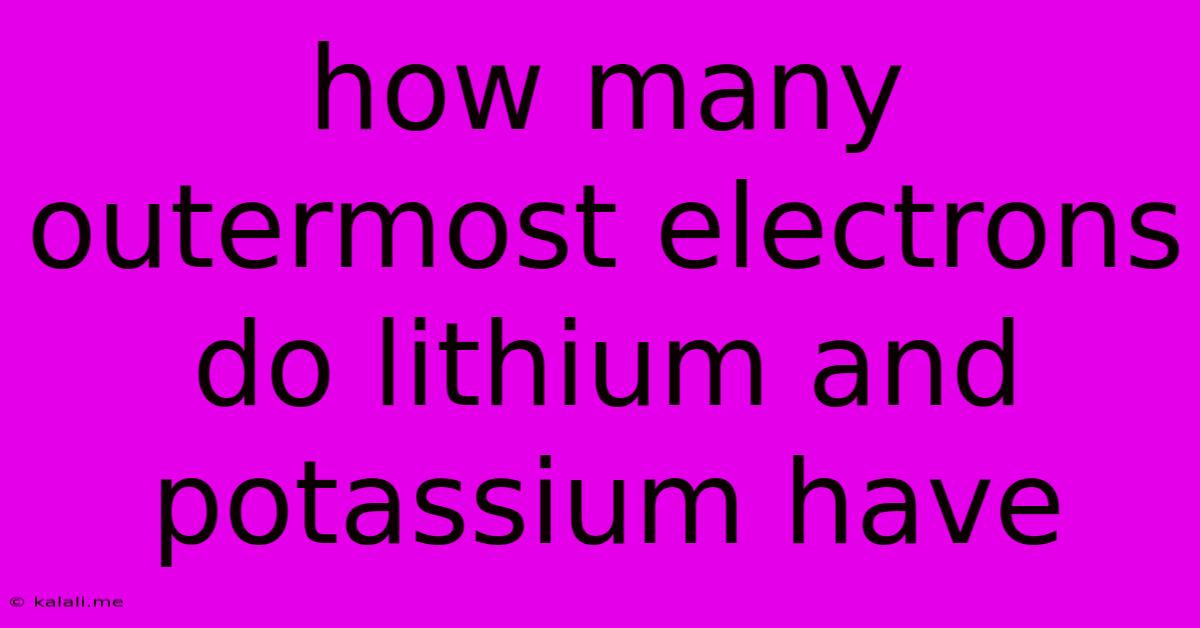How Many Outermost Electrons Do Lithium And Potassium Have
Kalali
Jun 14, 2025 · 2 min read

Table of Contents
How Many Outermost Electrons Do Lithium and Potassium Have? Understanding Valence Electrons
This article explores the number of outermost electrons, also known as valence electrons, possessed by lithium and potassium. Understanding valence electrons is crucial for comprehending an element's chemical behavior and its ability to form bonds with other elements. This knowledge is fundamental in chemistry and is often tested in high school and university-level chemistry courses.
What are Valence Electrons?
Valence electrons are the electrons located in the outermost shell or energy level of an atom. These electrons are the ones most involved in chemical reactions and bond formation. The number of valence electrons determines an element's reactivity and the types of chemical bonds it can form (ionic, covalent, or metallic). Elements with similar valence electron configurations often exhibit similar chemical properties – a key concept in the periodic table's organization.
Lithium (Li): Exploring its Electronic Structure
Lithium, with an atomic number of 3, has three electrons in total. Its electronic configuration is 1s²2s¹. This means:
- The first energy level (n=1) contains two electrons in the 1s orbital.
- The second energy level (n=2) contains one electron in the 2s orbital.
Therefore, lithium has one valence electron located in its outermost shell (n=2). This single valence electron makes lithium highly reactive, readily losing this electron to achieve a stable electron configuration similar to helium (a noble gas).
Potassium (K): A Deeper Dive into its Valence Electrons
Potassium, possessing an atomic number of 19, has a more complex electronic configuration: 1s²2s²2p⁶3s²3p⁶4s¹. Let's break this down:
- The first three energy levels are filled with electrons.
- The outermost shell (n=4) contains one electron in the 4s orbital.
Similar to lithium, potassium also has one valence electron. This lone electron in the outermost shell makes potassium highly reactive, readily participating in chemical reactions to achieve a stable noble gas configuration similar to Argon.
Comparing Lithium and Potassium: Similarities and Differences
Both lithium and potassium are alkali metals, located in Group 1 of the periodic table. This group is characterized by elements having one valence electron. This shared characteristic explains their similar reactivity and tendency to form +1 ions. However, due to the increasing number of electron shells as you move down the group, potassium is more reactive than lithium because its outermost electron is further from the nucleus and therefore less strongly held.
Conclusion: The Significance of Valence Electrons
Understanding the number of valence electrons is fundamental to predicting the chemical behavior of elements. Both lithium and potassium, with their single valence electron, exemplify the reactivity characteristic of alkali metals. This knowledge forms the foundation for understanding chemical bonding, reactivity, and the periodic table's organization. Remember that the number of valence electrons dictates how an element will interact with other elements, shaping the incredible diversity of chemical compounds found in the world around us.
Latest Posts
Latest Posts
-
How Many Naturally Occurring Elements Are On Earth
Jun 15, 2025
-
What Is The Most Important Factor In Successful Learning
Jun 15, 2025
-
What Two Numbers Multiply To 32
Jun 15, 2025
-
Respiratory System Questions And Answers Pdf
Jun 15, 2025
-
Which Of The Following Are Two Classes Of Resistors
Jun 15, 2025
Related Post
Thank you for visiting our website which covers about How Many Outermost Electrons Do Lithium And Potassium Have . We hope the information provided has been useful to you. Feel free to contact us if you have any questions or need further assistance. See you next time and don't miss to bookmark.